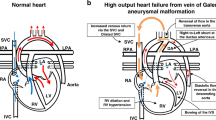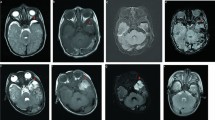Abstract
Hereditary hemorrhagic telangiectasia (HHT) is an autosomal dominant disorder characterized by mucocutaneous telangiectases and arteriovenous malformations (AVMs). The disease rarely presents in the neonatal period, primarily manifesting with epistaxis and gastrointestinal bleeding in adulthood. Occasionally, HHT can also present with symptoms related to AVMs in the cerebral, pulmonary or gastrointestinal vasculature. In prior reports, intracranial hemorrhage (ICH) secondary to cerebral AVM in neonates with HHT has been catastrophic and uniformly fatal. Here we report a case of a newborn with HHT and ICH from a suspected AVM who survived with aggressive medical management and surgical intervention, and provide a comprehensive review of the literature on ICH in neonates with HHT.
This is a preview of subscription content, access via your institution
Access options
Subscribe to this journal
Receive 12 print issues and online access
$259.00 per year
only $21.58 per issue
Buy this article
- Purchase on Springer Link
- Instant access to full article PDF
Prices may be subject to local taxes which are calculated during checkout



Similar content being viewed by others
References
Giordano P, Nigro A, Lenato GM, Guanti G, Suppressa P, Lastella P et al. Screening for children from families with Rendu-Osler-Weber disease: from geneticist to clinician. J Thromb Haemost 2006; 4: 1237–1245.
Morgan T, McDonald J, Anderson C, Ismail M, Miller F, Mao R et al. Intracranial hemorrhage in infants and children with hereditary haemorrhagic telangiectasia (Osler-Weber-Rendu syndrome). Pediatrics 2002; 109: E12.
Bourdeau A, Cymerman U, Paquet M-E, Meschino W, McKinnon WC, Guttmacher AE et al. Endoglin expression is reduced in normal vessels but is still detectable in arteriovenous malformations of patients with hereditary hemorrhagic telangiectasia type I. Am J Pathol 2000; 156: 911–923.
Kuo Y-H, Santoreneos S, Roos D, Brophy BP . Treatment of multiple arteriovenous malformations in pediatric patients with hereditary hemorrhagic telangiectasia and spontaneous hemorrhage. Report of two cases. J Neurosurg 2007; 107: 489–494.
Maher CO, Piepgras DG, Brough Jr RD, Friedman JA, Pollock BE . Cerebrovascular manifestations in 321 cases of hereditary hemorrhage telangiectasia. Stroke 2001; 32: 877–882.
Boynton R, Morgan B . Cerebral arteriovenous fistula withpossible hereditary telangiectasia. Am J Dis Child 1973; 125: 99–101.
Roy C, Noseda G, Arzimanoglou A, Harpey JP, Binet MH, Vaur C et al. Maladie de Rendu-Osler révélée par la rupture d’un anévrysme artériel cérébral chez un nourrisson. Arch Fr Pediatr 1990; 47: 741–742.
Putman C, Chaloupka J, Fulbright R, Awad A, White R, Favad P et al. Exceptional multiplicity of cerebral arteriovenous malformations associated with hereditary hemorrhagic telangiectasia (Osler-Weber-Rendu Syndrome). AJNR Am J Neuroradiol 1996; 17: 1733–1742.
Krings T, Ozanne A, Chng SM, Alvarez H, Rodesch G, Lasjaunias PL . Neurovascular phenotypes in hereditary haemorrhagic telangiectasia patients according to age. Review of 50 consecutive patients aged 1 day-60 years. Neuroradiology 2005; 47: 711–720.
Lobato RD, Perez C, Rivas JJ, Cordobes F . Clinical, radiological, and pathological spectrum of angiographically occult intracranial vascular malformations. Analysis of 21 cases and review of the literature. J Neurosurg 1988; 68: 518–531.
Author information
Authors and Affiliations
Corresponding author
Ethics declarations
Competing interests
The authors declare no conflict of interest.
Additional information
Disclaimer
The views expressed in this abstract/manuscript are those of the author(s) and do not reflect the official policy or position of the Department of Army, Department of Defense or the US Government.
Supplementary Information accompanies the paper on the Journal of Perinatology website
Supplementary information
Rights and permissions
About this article
Cite this article
Delaney, H., Rooks, V., Wolfe, S. et al. Term neonate with intracranial hemorrhage and hereditary hemorrhagic telangiectasia: a case report and review of the literature. J Perinatol 32, 642–644 (2012). https://doi.org/10.1038/jp.2011.146
Received:
Revised:
Accepted:
Published:
Issue Date:
DOI: https://doi.org/10.1038/jp.2011.146



